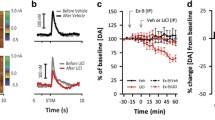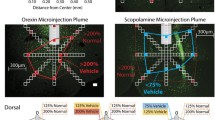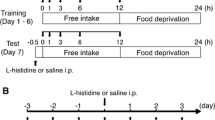Abstract
The assumption that drugs used as unconditioned stimuli in conditioned taste aversion (CTA) studies act centrally was tested by comparing the effects of systemic and intracerebral injections of harmaline hydrochloride (H) in 340 rats. Intraperitoneal injection of 5–20 mg/kg but not of 2.5 mg/kg H administered 5 min after 15-min saccharin (0.1%) drinking decreased saccharin-water preference in a two-choice retention test, performed 48 h later, from 55% to 20%. Since CTA was not diminished when H (10 mg/kg) was injected into rats anesthetised immediately after saccharin drinking by pentobarbital (40 mg/kg), H (1.7–50 μg) was administered intracerebrally to anesthetised rats fixed in the stereotaxic apparatus. Injection of 3–6 μg H into the inferior olive elicited CTA comparable to that of systemic injection of 10 mg/kg H. Injections of 6 and 50 μg H into cerebellum and bulbar reticular formation elicited weaker CTA while neocortical, hypothalamic and mesencephalic applications were ineffective. CTA could also be elicited when 50 μg but not 6 μg H was injected into the inferior olive 1 or 2 h after saccharin drinking. This delay-dependent effect and failure of non-contingent H administration to change saccharin preference indicates that the H-induced CTA is not contaminated by a non-specific increase in neophobia. It is concluded that H probably elicits CTA by activation of caudal bulbar structures, including the nucleus of the solitary tract, area postrema and lateral reticular formation.
Similar content being viewed by others
References
Amit Z, Levitan DE, Brown ZW, Rogan F (1977) Possible involvement of central factors in the mediation of conditioned taste aversion. Neuropharmacology 16:121–124
Ashe JH, Nachman M (1980) Neural mechanisms in taste aversion learning. Prog Psychobiol Physiol Psychol 9:233–262
Barker LM, Best MR, Domjan M (eds) (1977) Learning mechanisms in food selection. Baylor University Press, Waco
Batini C, Bernard JF, Buisseret-Delmas C, Conrath-Verrier M, Horcholle-Bossavit G (1981a) Harmaline induced tremor. II. Unit activity correlation in the interposito-rubral and oculomotor systems of cat. Exp Brain Res 42:383–391
Batini C, Buisseret-Delmas C, Conrath-Verrier M (1981b) Harmaline-induced tremor. I. Regional metabolic activity as revealed by (14C)2-deoxyglucose in cat. Exp Brain Res 42:371–382
Berger BD, Wise CD, Stein L (1973) Area postrema damage and bait shyness. J Comp Physiol Psychol 82:475–479
Braun JJ, McIntosh H Jr (1973) Learned taste aversions induced by rotational stimulation. Physiol Psychol 1:301–304
Bureš J, Burešová O (1981) Elementary learning phenomena in food selection. In: Ádám G, Mészáros I, Bányai ÉI (eds), Ady Physiol Sci, vol. 17, Brain and Behaviour, Akadémiai Kiadó, Budapest
Burešová O, Bureš J (1977) The effect of anaesthesia on acquisition and excitation of conditioned taste aversion. Behav Biol 20:41–50
Burešová O, Semenov LV, Bureš J (1982) Electrical stimulation or chemical blockade of vestibular nuclei can serve as the unconditioned stimulus in the conditioned taste aversion paradigm. Acta Biol Acad Sci Hung 33:139–148
Coil JD, Rogers RC, Garcia J, Novin D (1978) Conditioned taste aversions: Vagal and circulatory mediation of the toxic unconditioned stimulus. Behav Biol 24:509–519
Conrad LCA, Leonard CM, Pfaff DW (1974) Connections of the median and dorsal raphe nuclei in the rat: An autoradiographic and degeneration study. J Comp Neurol 156:179–206
Fifková E, Maršala J (1967) Stereotaxic atlases for the cat, rabbit, and rat. In: Bureš J, Petráň M, Zachar J (eds) Electrophysiological methods in biological research. Academic Press, New York, pp 653–731
Fuentes JA, Long VG (1971) An investigation on the central effects of harmine, harmaline and related beta-carbolines. Neuropharmacology 10:15–23
Garcia J, Kimeldorf DJ, Koelling RA (1955) Conditioned aversion to saccharin resulting from exposure to gamma radiation. Science 122:157–158
Goudie AJ (1979) Aversive stimulus properties of drugs. Neuropharmacology 10:971–979
Green L, Rachlin H (1976) Learned taste aversions in rats as a function of delay, speed and duration of rotation. Learning and Motivation 7:283–289
Greenshaw AJ, Burešová O (1982) Learned taste aversion to saccharin following intraventricular or intraperitoneal administration of d,l-amphetamine. Pharmacol Biochem Behav 17:1129–1133
Headley PM, Lodge D, Duggan AW (1976) Drug-induced rhythmical activity in the inferior olivary complex of the rat. Brain Res 101:461–478
Hutchison SL Jr (1973) Taste aversion in albino rats using centrifugal spin as an unconditioned stimulus. Psychol Rep 33:467–470
Knowles WD, Phillips MI (1977) Drug-induced tremor: effects of brain development and anesthetics. Soc Neurosci Abstr 3:110
Lamarre Y, De Montigny C, Dumont M, Weiss M (1971) Harmaline-induced rhythmic activity of cerebellar and lower brainstem neurons. Brain Res 32:246–250
Lorden JF, Margules DL (1977) Enhancement of conditioned taste aversions by lesions of the midbrain raphe nuclei that deplete serotonin. Physiol Psychol 5:273–279
Lorden JF, Oltmans GA (1978) alteration of the characteristics of learned taste aversion by manipulation of serotonin levels in the rat. Pharmacol Biochem Behav 8:13–18
Milgram NW, Krames L, Alloway FM (eds) (1977) Taste aversion learning, Plenum Press, New York
Myers RH, De Castro JM (1977) Learned aversions to intracerebral carbochol. Physiol Behav 10:73–78
Robertson HA (1980) Harmaline induced tremor: interaction with the benzodiazepine receptor as a possible mechanism of action. Soc Neurosci Abstr 6:278
Roll DL, Smith JC (1972) Conditioned taste aversion in anesthetised rats. In: Seligman MEP, Hager JL (eds) Biological boundaries of learning. Appleton-Century-Crofts. New York, pp 98–102
Sjölund B, Björklund A, Wiklund L (1977) The indolaminergic innervation of the inferior olive. 2. Relation to harmaline induced tremor. Brain Res 131:23–37
Wang RY, Aghajanian GK (1977) Inhibition of neurons in the amygdala by dorsal raphe stimulation: mediation through a direct serotonergic pathway. Brain Res 120:85–102
Wang SC, Borison HL (1952) A new concept of organization of the central emetic mechanisms: recent studies on the sites of action of apomorphine, copper sulfate and cardiac glycosides. Gastroenterology 22:1–12
Author information
Authors and Affiliations
Rights and permissions
About this article
Cite this article
Burešová, O., Bureš, J. Central mediation of the conditioned taste aversion induced in rats by harmaline. Psychopharmacology 83, 384–389 (1984). https://doi.org/10.1007/BF00428552
Received:
Accepted:
Issue Date:
DOI: https://doi.org/10.1007/BF00428552




